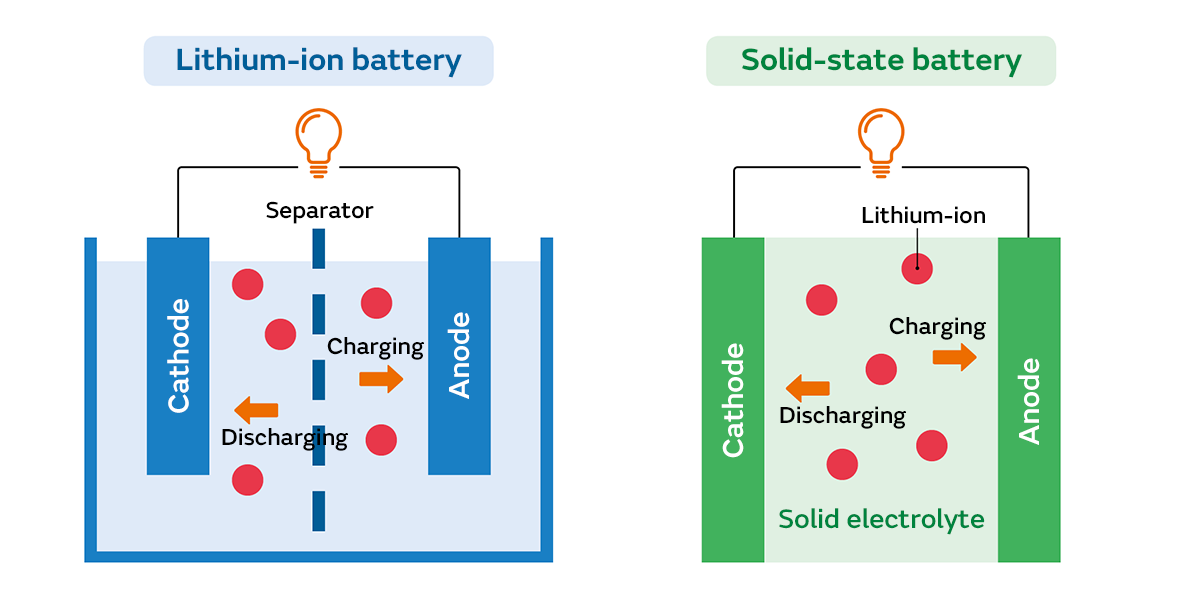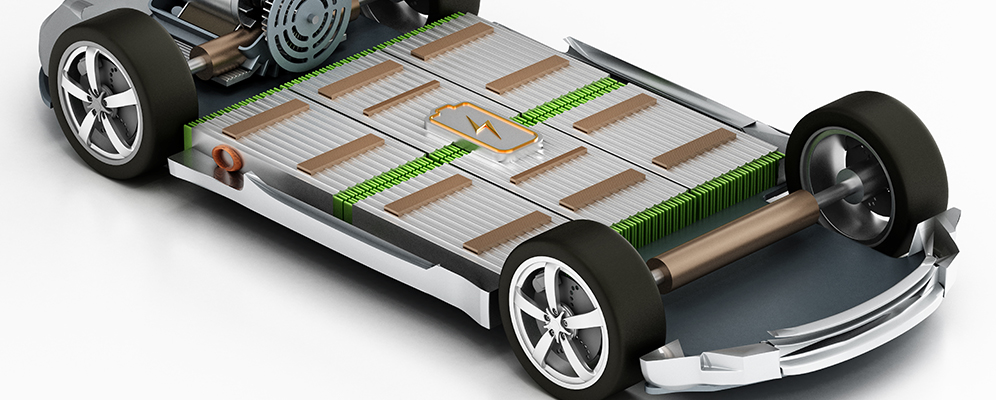Welcome to a breathtaking paradigm shift in electro-mobility. Imagine an electric vehicle (EV) world where charging is incredibly rapid, driving range extends far beyond what it is today, and fire-risk concerns are entirely null and void. Thanks to the dawning age of solid-state batteries – a cutting-edge technology expected to revolutionize the EV landscape – this dream seems closer to becoming an everyday reality.-Previous
What are Solid-State Batteries?

Imagine a world where charging your electric vehicle takes less time than gulping down a cup of morning Joe, and with enough juice to zip across several state lines before needing to recharge. Sounds like science fiction, right? It’s not. Here to potentially turn this sci-fi scenario into reality are solid-state batteries.
To explain solid-state batteries, let’s first get a handle on how traditional batteries, specifically Lithium-ion batteries, work. These little electricity factories use a liquid electrolyte to move lithium ions between the positive (cathode) and negative (anode) ends of the battery, creating a flow of electrons, i.e., our good friend electricity.
Now, solid-state batteries shake up this chemistry-cum-physics. Instead of a liquid electrolyte, a solid one is used. It can be ceramic, glass, or some other kind of solid conductor. The advantages here are promising enough to make some of the biggest electrical engineers grin like kids in a candy store.
Why? Because the solid electrolyte is not flammable like the liquid electrolyte used in conventional lithium-ion batteries. It’s like transforming a highly enthusiastic firecracker into a solid chunk of, well – almost inert matter. The result? Lesser risk of overheating and catching fire, translating into safer electric vehicles (EVs) we’d all be happier to bet our lives on.
Another major bonus of these solid-state batteries is that they are denser and can, therefore, pack more energy into the same amount of space. More energy density means getting more mileage from your EVs before having to recharge, rendering range anxiety – that perpetual worry of running out of battery miles away from a charging station – a thing of the past.
The bottom line here is that solid-state batteries have the potential to make EVs safer, more efficient, and capable of longer range. It has ‘Game-changer’ written all over it and could give electric vehicles that extra jolt they need to dominate the automotive market once and for all.
Indeed, technology doesn’t just saunter forward–it leaps and bounds, and solid-state batteries look set to become one of those giant, earth-shaking strides. And like they say, the electrifying future of EVs is not only solid but also incredibly promising!
The Benefits of Solid-State Batteries in EVs

Beyond a shadow of a doubt, solid-state batteries herald a new era of technological innovation that stands to significantly enhance electric vehicles’ overall performance. These revved-up powerhouses pack a potent punch of benefits, making them the clear frontrunner in the race towards an electrified automobile future.
First off, solid-state batteries boast increased energy density. Simply put, they store more power than their liquid-based lithium-ion counterparts in the same amount of space. This means that EVs equipped with solid-state batteries can drive further on a single charge, effectively addressing ‘range anxiety’—a critical concern that deters potential EV consumers who worry about running out of juice mid-journey.
Second, these batteries are touted for their superior safety profile. Traditional batteries deploy a liquid or gel electrolyte that can leak or, worse, ignite under certain conditions. By replacing the volatile liquid with a non-flammable solid, the likelihood of the battery ‘going up in smoke’ is significantly reduced—a prospect any driver would appreciate!
Let’s not forget the sharp reduction in charging times, which has potential to revolutionize the EV charging experience. Solid-state batteries not only can ‘fill up’ faster than lithium-ion batteries, but they also have a longer lifespan due to less wear and tear at high levels of charge. Thus, EV owners might spend less time plugged in at charging stations and more time conquering the roads with their electrified rides.
Another gem in the solid-state crown is the eco-friendliness. The absence of rare and potentially harmful metals, like cobalt, in the manufacturing process gives them an environmental edge. This aligns perfectly with the green motivations of many EV consumers.
Lastly, solid-state batteries have a potential advantage in terms of size and weight. They can be engineered to be thinner and lighter than lithium-ion batteries. This trimmer silhouette could conceivably free up designers to rethink the fundamentals of car design. Think sleeker, lighter, and more aerodynamic shapes that enhance speed and efficiency.
In a nutshell, solid-state batteries could offer EVs more power, more mileage, faster recharge time, longer lifespan, increased safety, and less environmental impact. The solid-state EV revolution may just tilt the planetary scales toward a more sustainable, carbon-neutral future. It’s like having your electric cake and driving it too.
Current Challenges of Solid-State Batteries

As exponential as the promise for solid-state batteries appears, several notable hurdles must be scaled before they can replace existing lithium-ion batteries in electric vehicles. It’s a bit like when your kid has been crowned the pie-eating champion at the summer fair; the accomplishment is admirable, but there’s a huge mound of whipped cream smeared all over the immediate future.
One of the primary challenges is manufacturing. Solid-state batteries are notoriously tricky to build on a massive scale due to their current design complexities. There’s a certain daunting precision required, and with precision comes cost. We’re talking about jumping from a level of production akin to churning out boxes of cereal to creating diamond-encrusted wristwatches en masse.
Additionally, in their present form, solid-state batteries require elevated temperatures to perform optimally. Within the controlled environment of a lab, maintaining these conditions is relatively simple. However, replicating the same performance in the typically fluctuating conditions under the hood of a car is quite a different ball game. The final product has to be able to stand up to the deep winter chill of Anchorage and the blazing summer heat of Phoenix.
Another key challenge is the risk of dendrite formation. These freewheeling metal tendrils have an unappetizing habit of growing through the electrolyte, often leading to short circuits. Whenever electricity and metal meet in a way that’s unintended, it never ends well for the electronics involved.
There’s also the issue of energy density. Contrary to popular assumptions, not all solid-state batteries are automatically superior to their liquid-state counterparts in this regard. The truth is that achieving high energy density in solid-state batteries, while maintaining safety and life-span, is no walk in the park.
Lastly, there’s the all-important factor of cost-effectiveness. Convincing automakers to make the leap from the familiar territory of lithium-ion batteries to the new frontier of solid-state batteries will require robust assurances that they won’t be forced into bankruptcy by battery costs. In a price-sensitive market, premium costs of these up-and-coming batteries may be a substantial barrier to wide-scale adoption.
Peak performance of solid-state batteries in the lab can give the impression that the reign of lithium-ion batteries is at the brink of termination. However, the road from promising lab results to widespread commercial use is paved with a whole bunch of research, development, and cost-effective manufacturing – kind of like scaling Mt. Everest in shorts, you might say.
The Future of Solid-State Batteries in EVs
Peering into the crystal ball of the automobile industry, the future of solid-state batteries in electric vehicles (EVs) shows enormous promise.
These batteries are set to empower EVs with more mileage per charge cycle, enhanced safety, and faster charge-and-discharge rates compared to the typical lithium-ion batteries that dominate today. Presently, certain companies are already making strides in deploying solid-state technology. One example is Volkswagen, which has invested heavily in QuantumScape, a company that’s rolling up its sleeves to specialize in solid-state technology. QuantumScape is poised to enter their EV battery production phase by 2024.
Toyota is another heavy player in this field. With its reputation for being a pioneer in hybrid technology, it is pushing for the commercial viability of solid-state batteries, set to debut their version in a range of EVs by 2025. Simultaneously, BMW also affirms optimism on these batteries and aspires to have an EV powered by solid-state batteries in its future lineup.
At a granular level, researchers are blazing forward, experimenting with different materials for solid electrolytes, including glass, ceramics, polymers, and sulfides. Some are optimistic that we may achieve solid-state batteries with lithium metal anodes, effectively dodging the restraints of lithium-ion batteries like limited energy density.
Interestingly, government policies are also likely to be instrumental in the big leap. As they increasingly push for low emission vehicles to counteract the intensifying climate change, subsidies and incentives for EVs could bolster the demand for advanced batteries, including solid-state ones.
A lot of eyes are also focusing on the pricing factor. Initial estimates propose that the cost of solid-state batteries could be on par with lithium-ion batteries by 2027. As the production of these batteries scales up and manufacturers find ways to reduce the production costs, it’s likely that the prices will drop, thereby acquiring a fast track to mainstream acceptance.
However, it’s essential not to view this as a simple transition from one type of battery to another. The key lies in taking the EV industry to new horizons. Solid-state batteries could contribute to lighter, more powerful vehicles that give rise to novel designs and styling cues. The removal of bulky battery spaces could pave the way for significant alterations in the design and engineering of electric vehicles.
In sum, the advent of solid-state batteries in EVs can be thought of as a master key that could unlock multiple doors to the future of the EV industry – more robust, safer, cost-effective, and potentially, even more, environmentally friendly. However, there will certainly be a cat-and-mouse game between promise and delivery, hypothesis and realization, potential and actualization. What remains unambiguous is that the journey toward this new horizon, whether tumultuous or smooth, will decidedly be game-changing.
FAQs
What signifies the advent of solid-state batteries in electric vehicles?
Are solid-state batteries better than lithium-ion batteries?
When can we expect solid-state batteries in mainstream electric vehicles?
Conclusion
As solid-state batteries drive into the immediate horizon, we can anticipate a profound alteration in the electric vehicle (EV) landscape. These high-capacity, fast-charging powerhouses promise not just an elevation in performance but also a potential solution to range anxiety. It’s an exciting time for EV enthusiasts as the union of performance, convenience, and green beginnings to mirror traditional powered rallying counterparts. A future where ‘going electric’ represents no compromises is certainly worth the wait!
